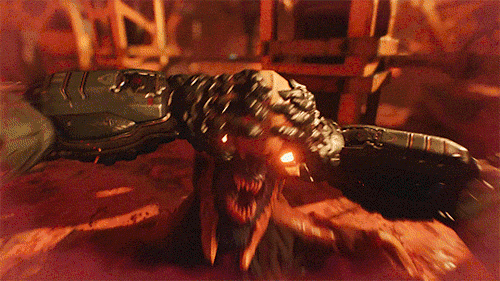Memorable Mechanics is a bi-weekly column highlighting memorable gameplay mechanics and level design of both past and present video games. 2016’s Doom not only revitalized a franchise but served as a case study for implementing change to classic franchises. Drastic change that built upon classic Doom’s roots instead of rewriting them. Also, ripping demons in half is cool and fun or whatever.
Enjoy.
Hell played a pivotal role in shaping my taste in video games as an adolescent. More specifically, id Software’s vision of hell with their first-person masterpiece Doom. Doom completely changed my perception of what video games could be, not only because of its mature content but the way in which it played. Sure, I had played id’s other FPS’, Wolfenstein 3D, and Bungie’s Marathon, but neither of them captured the sense of speed and pixelated chaos like Doom did.
Doom was always synonymous with chaos, given its fast-paced combat as well as the hordes of enemies and projectiles necessary to tear through. This sense of speed was absent from 2004’s Doom 3, which put it at odds with previous versions. While it was executed well, with tense and atmospheric horror elements, these were never gameplay elements that made the original Doom so timeless. This shift in the pacing of gameplay fundamentally changed the Doom experience in its entirety, resulting in a game very unlike classic Doom.
The player’s movement speed is vital to the identity of Doom. It not only affects the player’s maneuverability but environments were created with this maneuverability in mind. Large, open environments allow for plenty of side strafing and sprinting towards ammo or enemies, which are vital to the Doom experience. So, when it was announced that ID Software would be releasing 2016’s Doom, I was skeptical as to whether or not an emphasis on fast and fluid gameplay would return.
Honestly, if anything, Doom’s E3 demo trailer took my skepticism and hurled it into the stratosphere. Climbing? Jumping? Glory Kills? Inevitably, these mechanics that are so fundamentally un-Doom would result in a weird platform shooter brawler mash-up. As happens with a majority of gut-reactions, my worry was completely unfounded and in the end, taught me that change is good.

Hell, change is a necessity in franchises as old as Doom. Change isn’t something to be feared – and should be encouraged – and Doom is a flawless example of this with its inclusion of glory kills.
No single gameplay element has been more revolutionary for Doom than glory kills. When an enemy sustains enough damage, they begin to glow, indicating the player can perform a melee execution attack known as a glory kill. In addition to these slick and gratifying combat animations (seriously, they are rad), enemies will drop health and ammo, making it an essential life-saving strategy. This mechanic actively encourages players to seek out combat given that the health and ammo resting within a nearby demon’s ribcage is all that usually stands between the player and death.
In theory, the idea of momentarily slowing down the gameplay for this combat animation to unfold would be counterintuitive to the fluidity of gameplay, but in practice, it’s incredibly spontaneous. Glory kills unfold quickly, just long enough to allow the player to catch their breath before jumping back into the thick of demon killing. The fact that glory kills were designed to coincide with the game’s emphasis on speed and fluidity speaks to Doom’s roots. Glory kills never seem out of place, given that they aid the classic Doom mechanics that id Software placed such a heavy emphasis on.
Doom’s reboot was so successful because it didn’t overcomplicate things. Doom is about killing demons as quickly as possible, and anything that stands in the way of that is a detriment to the overall experience. Part of why Doom 3 and its expansion pack failed to resonate with some in the Doom fandom is that it didn’t feel entirely like Doom. For every claustrophobic and dimly lit corridor, the player’s movement speed was severely restricted. Doom 3’s environmental parameters were designed solely with atmosphere, and not gameplay, in mind, so it was a tremendous relief that the reboot was dedicated to tapping into what made the classic so timeless. By adding more modern features to gameplay –features that support pre-existing mechanics rather than rewrite them– the core of what made the original Doom so enjoyable still shines through the new.
Glory kills really shouldn’t have worked as well as they do in Doom, and yet, their implementation was organic and showed that no matter how many decades a franchise’s history spans, change is good. Change brings about new and unique experiences, and in Doom’s case, helps to modernize classic gameplay mechanics while evolving a franchise.
Some of the coverage you find on Cultured Vultures contains affiliate links, which provide us with small commissions based on purchases made from visiting our site.

